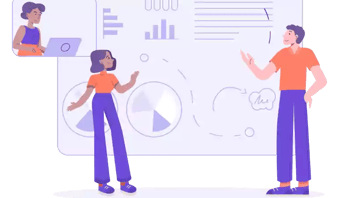What is Webinar Marketing, and Why Does It Matter?
In the fast-paced world of digital marketing, webinars have emerged as a potent tool for businesses to reach, engage, and convert their target audience. 91% of B2B marketers leverage webinars as content strategy, underscoring their effectiveness in driving results.
So, what exactly is webinar marketing?

What is Webinar Marketing?
Webinar marketing involves hosting online seminars or presentations via video conferencing platforms. These live or pre-recorded sessions offer a valuable opportunity for businesses to share knowledge, connect with their audience, and generate leads. By providing valuable content and engaging with attendees in real-time, webinars create a personalized and interactive experience that fosters more profound connections.
Key elements of webinar marketing include:
-
Content Delivery: Sharing knowledge, expertise, or product information through a structured presentation.
-
Audience Engagement: Encouraging participation through features like Q&A sessions, polls, and chat.
-
Lead Generation: Capturing attendee information for future marketing efforts.
-
Brand Building: Enhancing brand awareness and reputation as a thought leader.
By effectively combining these elements, businesses can leverage webinars to achieve their marketing goals, build relationships, and drive growth.
The Benefits of Webinar Marketing
The benefits of webinar marketing are manifold:
-
Brand Awareness: According to ON24, webinars attract 37% more attendees than in-person events. This increased reach allows businesses to expand their audience and position themselves as thought leaders.
-
Lead Generation and Nurturing: Webinars can convert between 5% and 10% of attendees into leads. By providing valuable content and capturing attendee information, businesses can build a targeted list of potential customers and nurture them through their sales funnel.
-
Customer Engagement: 73% of B2B and B2C marketers believe webinars effectively build relationships. By offering interactive experiences and addressing customer questions, webinars create a sense of community and foster loyalty.
-
Thought Leadership: 60% of attendees view companies that host webinars as industry leaders. By sharing expert insights and valuable information, businesses can position themselves as trusted sources of knowledge and expertise.
-
Cost-effective Marketing: Webinars can be organized with a fraction of the budget, without the need for physical venues, travel expenses, or catering costs. This makes them an attractive option for businesses of all sizes.
In essence, webinar marketing is a strategic approach that combines the power of online content delivery with the benefits of live interaction. Businesses can effectively leverage this tool to achieve their marketing objectives, build relationships, and drive growth.
How to Plan a Winning Webinar
1. Define Your Target Audience
The foundation of a successful webinar lies in understanding your ideal attendee. By identifying their pain points, interests, and challenges, you can tailor your content to resonate with their needs and increase engagement.
Here are some tips for conducting audience research:
-
Surveys: Create targeted surveys to gather specific information about your audience's demographics, preferences, and goals.
-
Social Media Analysis: Monitor social media platforms to identify trending topics, discussions, and common questions within your industry.
-
Customer Interviews: Conduct one-on-one interviews with existing customers to gain deeper insights into their needs and expectations.
Develop a Compelling Webinar Topic
Once you clearly understand your target audience, it's time to choose a webinar topic that will capture their interest and provide value. Consider the following factors:
-
Relevance: Ensure the topic aligns with your audience's needs and pain points.
-
Keyword Research: Use tools like Google Trends and SEO software to identify popular keywords and search terms related to your topic. This will help you optimize your webinar for search engines and attract organic traffic.
-
Uniqueness: Offer a fresh perspective or a unique solution to a common problem.
Here are some examples of high-performing webinar topics for different industries:
-
Healthcare: "The Future of Telemedicine: Transforming Patient Care"
-
Technology: "Demystifying AI: Practical Applications for Businesses"
-
Education: "Engaging Students in the Digital Age: Innovative Teaching Strategies"
-
Finance: "Investing in Real Estate: Tips for Beginners"
-
Marketing: "Content Marketing That Converts: Strategies for Success"
Craft an Invitation
Your webinar invitation is the first impression attendees will have of your event. It should be compelling and informative and encourage registration. Here are some tips for crafting an effective invitation:
-
Title: Use a strong, attention-grabbing title that communicates the benefits of attending the webinar. For example, "Unlock the Secrets to [Audience Pain Point] in Our Free Webinar."
-
Description: Provide a brief overview of the webinar content, highlighting the key takeaways and benefits for attendees.
-
Call to action (CTA): Use a clear and compelling CTA to encourage registration, such as "Register Now" or "Reserve Your Spot."
Build Your Webinar Landing Page
Your webinar landing page should be designed to convert visitors into registrants. Here are some essential elements to include:
-
Appealing visuals: Use high-quality images and graphics to make your landing page visually appealing.
-
Clear information: Communicate the webinar's topic, date, time, and registration details.
-
Easy registration form: Keep the registration form short and simple to avoid deterring potential attendees.
-
Social proof: Include testimonials, reviews, or logos of past attendees' companies to build credibility.
-
Optimized for conversions: Place your CTA button prominently on the page and ensure it stands out.
Following these guidelines can help you create a webinar invitation and landing page that will attract your target audience and drive registrations.
Deliver a Dynamic Webinar Presentation
Structure and Flow
A well-structured webinar ensures a smooth and engaging experience for attendees. A typical webinar flow includes:
-
Introduction: Grab attention with a compelling opening, introduce the topic, and outline the key points.
-
Main content: Deliver the core of your presentation using clear and concise language supported by visuals.
-
Q&A session: Allow attendees to ask questions and provide valuable insights.
-
Conclusion: Summarize key points, reiterate the benefits, and provide a strong call to action.
Engage Your Audience
To keep your audience captivated throughout the webinar, incorporate interactive elements and deliver your content enthusiastically and confidently.
-
Interactive Elements:
-
Polls: Gauge audience opinions and preferences on specific topics.
-
Q&A breaks: Encourage participation and address attendee questions.
-
Group activities: Foster collaboration and engagement among attendees.
-
Presenter confidence and enthusiasm: Your energy and passion will be contagious. Project confidence and enthusiasm to inspire your audience.
-
Storytelling and case studies: Relatable stories and real-world examples can make your content more memorable and impactful.
Use Presentation Tools
The right webinar platform and tools can enhance your presentation and facilitate interaction with your audience.
-
Choosing the right platform: Consider factors such as audience size, desired features (e.g., polling, Q&A, screen sharing), and ease of use. Popular platforms include Zoom, GoToWebinar, and Microsoft Teams.
-
Mastering essential tools:
-
Slides: Use visually appealing slides with clear text and relevant images.
-
Screen sharing: Share your screen to demonstrate software, websites, or other materials.
-
Whiteboarding: Draw or write on a virtual whiteboard for real-time collaboration.
-
Leveraging polls and Q&A: Use these features to gather audience feedback and address their questions.
By carefully planning your webinar structure, engaging your audience, and utilizing effective presentation tools, you can deliver a dynamic and memorable experience that will leave a lasting impression.
Maximize Your Reach (and Results)
Promote Your Webinar
To ensure maximum reach and impact, promoting your webinar effectively before, during, and after the event is essential.
- Pre-Webinar Promotion:
-
Social media: Create engaging posts on LinkedIn, Twitter, and Facebook to generate buzz and drive registrations.
-
Email marketing: Send targeted email campaigns to your existing audience, highlighting the benefits of attending the webinar.
-
Paid advertising: Consider using paid advertising platforms like Google Ads or Facebook Ads to reach a wider audience.
- During the Webinar:
-
Encourage live participation: Use interactive elements like polls, Q&A sessions, and chat to engage attendees and encourage participation.
-
Promote social sharing: Encourage attendees to share the webinar on social media using branded hashtags.
- Post-Webinar Promotion:
-
Retargeting: Send personalized emails to past registrants who didn't attend the webinar, offering them a chance to watch the recording or access additional resources.
-
Social media recap: Share a recap of the webinar on social media, highlighting key takeaways and including a link to the recording.
Convert Attendees into Leads
To maximize the value of your webinar, focus on converting attendees into leads and nurturing them through your sales funnel.
-
Capture attendee information: Use registration forms to collect essential data such as name, email address, company, and job title.
-
Personalized follow-up: Send personalized emails to attendees, offering them valuable content, resources, or exclusive offers related to the webinar topic.
-
Post-webinar landing page: Create a dedicated landing page where attendees can access the webinar recording, download the slide deck, view a Q&A recap, and explore relevant offers.
Measure Your Success
To track the performance of your webinar and identify areas for improvement, it's essential to analyze key metrics and utilize webinar platform analytics tools.
-
Key metrics:
-
Registration rates: Measure the number of people who sign up for the webinar.
-
Attendance: Track the percentage of registered attendees who actually join the webinar.
-
Engagement: Measure attendee engagement through metrics like time spent watching, Q&A participation, and social sharing.
-
Webinar platform analytics: Leverage the analytics tools provided by your webinar platform to gain insights into attendee demographics, behavior, and satisfaction.
-
Iterate and improve: Analyze your webinar results to identify areas for improvement and make adjustments for future events.
By effectively promoting your webinar, converting attendees into leads, and analyzing your results, you can maximize its impact and achieve your marketing goals.
The Power of Webinar Marketing
Webinars have become indispensable tools for businesses looking to engage their audience, generate leads, and establish themselves as thought leaders. By providing valuable content, fostering interaction, and measuring results, webinars can help you achieve your marketing objectives.
Ready to take your webinar marketing to the next level? Aspiration Marketing offers expert guidance and support to help you plan, execute, and measure the success of your webinars.
Contact us today to learn more about how we can help you achieve your marketing goals.
This content is also available in:
- German: Was ist Webinar-Marketing, und warum ist es wichtig?
- Spanish: ¿Qué es el marketing de seminarios web y por qué es importante?
- French: Qu'est-ce que le marketing par webinaire ? Pourquoi est-il important ?
- Italian: Cos'è il Webinar Marketing e perché è importante?
- Romanian: Ce este Webinar Marketing și de ce este important?
- Chinese: 什么是网络研讨会营销,为什么它很重要?

Joachim is a certified HubSpot trainer with over 13 years of experience in content marketing, strategy, website development, and SEO. He has implemented numerous large-scale, international growth marketing programs, including one with UiPath, which grew from a startup to a successful IPO on the NYSE. Joachim has special expertise in multilingual marketing and sales enablement projects, and he uses the latest AI technologies to help our clients.









Leave a Comment